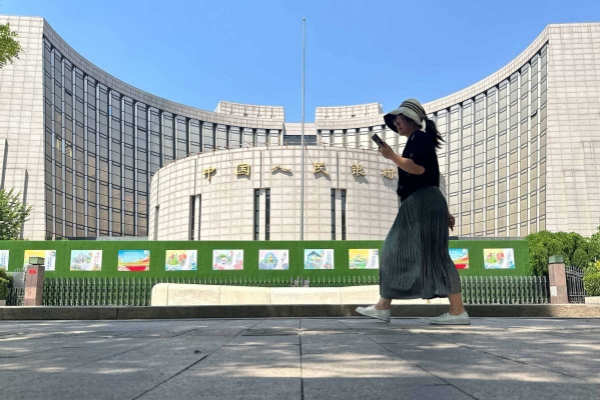Two new tools to guide interest rates

A pedestrian walks past the headquarters of the PBOC in Beijing. JIANG QIMING/CHINA NEWS SERVICE
The People's Bank of China, the country's central bank, has launched a pair of new tools to better guide market interest rates and ensure bond market stability, reinforcing its efforts to build a modern monetary policy system, experts said.
The PBOC said on Monday that, from now on, it would conduct temporary repurchase and reverse repurchase agreements — also known as temporary repos and reverse repos — depending on market conditions.
Essentially, a central bank withdraws money from the banking system via repos, whereby it sells securities to commercial banks with a promise to repurchase them later at a higher price. Conversely, it injects liquidity through reverse repos by buying securities from commercial banks, with an agreement to sell them back later at a higher price.
The operations, with a term of overnight, will be conducted from 4 pm to 4:20 pm on working days as needed, in addition to the central bank's traditional morning operations of seven-day reverse repos.
The interest rates of the temporary repos and reverse repos will be 20 basis points below and 50 basis points above the seven-day reverse repo rate, or 1.6 percent and 2.3 percent at present, respectively.
This move came after Pan Gongsheng, governor of the PBOC, implied last month that the central bank will designate the seven-day reverse repo rate as the main policy rate benchmark and make efforts to narrow the interest rate corridor — a system that helps manage short-term interest rates in the economy. It is also used by central banks in Europe and the United States.
Wang Qing, chief macroeconomic analyst at Golden Credit Rating International, said the additional tools will help implement Pan's promise, helping reduce the volatility of short-term market interest rates and clearly convey the central bank's monetary policy signals.
Historical data showed that short-term interest rates in China could experience large fluctuations at month-end and quarter-end, which could, to some degree, disrupt market participants' perception of the central bank's policy stance and hinder the transmission of interest rates from the short term to the long term.
Wang said the new tools will narrow the interest rate corridor significantly from 245 basis points to 70 basis points and help stabilize expectations of short-term interest rates by setting 1.6 percent as the new lower limit for short-term market rates acceptable to the central bank and 2.3 percent as the upper limit.
The central bank can use temporary repos to absorb excess liquidity and prevent market rates from dropping below 1.6 percent and use temporary reverse repos to keep market rates from exceeding 2.3 percent, he said.
The new move comes close on the heels of the PBOC's agreements with commercial banks last week to borrow and sell treasury bonds, a measure to cool down a bond market rally and a decline in Chinese government bond yield. An excessively low bond yield could ignite pessimistic expectations of economic growth and trigger capital outflows.
Wen Bin, chief economist at China Minsheng Bank, said the PBOC has shown a strong commitment to preventing excessively low bond market rates with both the establishment of the new tools and agreements to sell treasury bonds.
After Monday's announcement, the yield of 10-year Chinese treasury bonds rose to about 2.29 percent on Monday, compared with about 2.26 percent on Friday. It, however, retreated to about 2.27 percent on Tuesday, according to market tracker Wind Info.
zhoulanxv@chinadaily.com.cn

 Sunflower fields in Ningbo offer tranquil summertime escape
Sunflower fields in Ningbo offer tranquil summertime escape  Foreign expats' discussion on CPC disciplines
Foreign expats' discussion on CPC disciplines  Five Principles of Peaceful Coexistence send a powerful global message
Five Principles of Peaceful Coexistence send a powerful global message 


